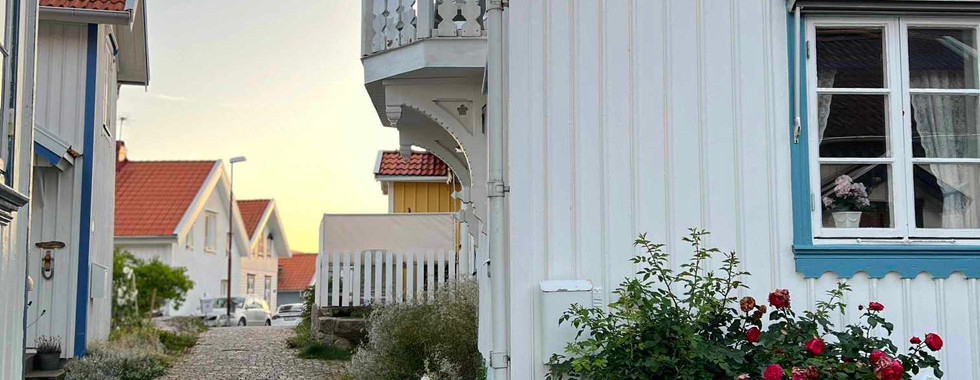(3)Day Three: Swedish "Mysig" and the Magic of Smögen
- Elflilja
- Sep 14, 2024
- 3 min read
Updated: Oct 11, 2024
The next morning, I woke up to a gloomy sky and 10°C—definitely not the most cheerful start, but I had to get outside a bit. The area was sparsely populated, and by almost every roadside garden, a bicycle lay there as if someone had rushed off to the store and just tossed it aside when they got home. I walked up a rocky path, typical of southwestern Sweden, where the landscape is filled with granite rocks stretching into the sea. As I walked, a light rain started to fall, so I headed back to the accommodation. Even with the drizzle, the cool, damp air was refreshing.
I had breakfast and coffee on the veranda, soaking in the typical Swedish "mysig" atmosphere. At one point, I noticed the automatic Husqvarna lawnmower pacing up and down the garden—it startled me for a moment! The grass here was lush and beautiful, and if it weren’t for those pesky Spanish slugs everywhere, I might have even danced with the lawnmower. :)

The first two days had been quite exhausting, so we took it easy in the morning. Since it was still raining a bit, we rested for quite a while, which meant we had to skip the town of Lysekil from our original plan. Once the rain stopped, we went to Smögen, a charming little fishing village famous for its colorful houses and the renowned Smögenbryggen. It was busier here, but we found a rocky area to climb. I believe this was part of the Kleven outdoor trail, which we didn’t even know about when planning our trip to Smögen. The place was magical, filled with beautiful plants and stunning views.
Climbing the rocks was fun, offering views of tiny islands, including Hållö, known for its lighthouses. We walked back to the car in the glow of a breathtaking sunset, strolling through the cozy, narrow streets.
We set off for our accommodation around 10 p.m., but it was still light out—the wonder of Scandinavian summer nights! Along the way, cows were peacefully grazing in the fields, and the best part was that I barely noticed any unpleasant farm odors typical of livestock. Free-range farming clearly benefits the environment and likely improves the quality of the meat and milk. Scandinavians really know how to live in harmony with nature.
More about Smögen:
Smögen is an iconic Swedish fishing village in the Bohuslän region, north of Gothenburg. It’s famous for Smögenbryggen, a long pier lined with colorful wooden houses that were once used by fishermen but are now home to restaurants, small shops, and cafés. Tourists flock here to enjoy the fresh sea air, local seafood, and the picturesque rocky landscape.
When visiting Smögen, be sure to take a walk along the Kleven trail, which winds through the rocks and offers fantastic views of the sea. You’ll see a variety of interesting plants in the area, and the peaceful atmosphere helps you unwind.
What is "MYSIG"?
The Swedish word "mysig" is hard to translate directly, but it roughly means "cozy," "comfortable," or "snug." It’s a way of life and a feeling that’s central to the daily lives of Scandinavians, especially Swedes. It can be an evening at home by candlelight, snuggling under a thick blanket in winter, or a family gathering with delicious food and conversation. The essence is that people feel relaxed, content, and safe.
Swedes put a lot of effort into making their homes comfortable and welcoming. Lighting plays a key role in this—soft, warm lights from candles or lamps enhance the "mysig" atmosphere. Simple yet stylish Scandinavian design is also part of this comfort. Candles were everywhere, in every place we stayed, even in places that didn’t have dish towels—so they’re clearly an essential!
The Swedish tradition of fika—taking a break for coffee and a treat—is also part of "mysig." It’s a time when people slow down and enjoy the moment with friends or family. This focus on savoring life’s small pleasures is key.
Because of the long, cold winters, Swedes especially value warmth and comfort. Winter "mysig" often involves thick blankets, hot drinks, and cozy evenings together, but it’s not just an indoor experience. People here love being out in nature—a peaceful walk in the forest, relaxing by a lake, or a quiet weekend at a cabin are all great ways to experience "mysig."
The philosophy of "mysig" is about finding peace and comfort in everyday life and intentionally creating an environment where you can unwind and recharge. It’s similar to the Danish concept of "hygge," but perhaps with a bit more calmness and connection to nature.























































Comments